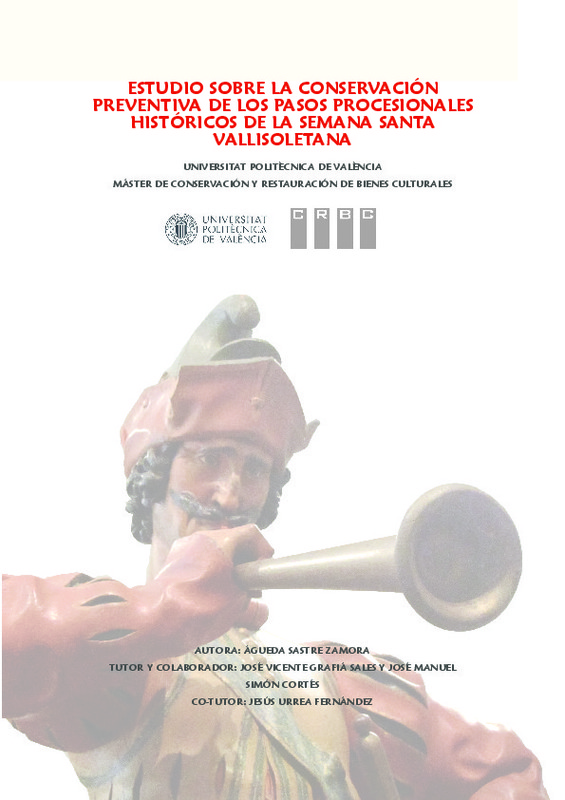|
Resumen:
|
[ES] La Semana Santa vallisoletana, con una tradición de más de cinco siglos, posee un interesante y valioso patrimonio material: sus pasos procesionales. La gran mayoría son obras de la importante Escuela Castellana del ...[+]
[ES] La Semana Santa vallisoletana, con una tradición de más de cinco siglos, posee un interesante y valioso patrimonio material: sus pasos procesionales. La gran mayoría son obras de la importante Escuela Castellana del barroco (con escultores tan destacados como Gregorio Fernández) y constituyen ejemplos clave para entender esta tipología artística. Por lo tanto podría decirse que la conservación de estas obras es prácticamente una obligación. El problema viene dado por la función procesional para la que fueron creadas y que hoy en día mantienen, ya que ésta se contrapone radicalmente a los parámetros de conservación preventiva establecidos por consenso: los pasos se ven expuestos una vez al año a condiciones ambientales y factores externos que aceleran su deterioro y en ocasiones las alteran irreversiblemente.
Por otra parte, el patrimonio inmaterial de la Semana Santa en la ciudad está muy arraigado en la cultura y tiene una gran importancia, por ello fue declarada Fiesta de Interés Turístico Internacional en 1980. Es por lo tanto imprescindible encontrar el equilibrio perfecto entre el patrimonio material e inmaterial para que la conservación de ambos quede asegurada. No se pretende con ello suprimir tradiciones para asegurar la preservación de las esculturas, sino hallar unos parámetros mínimos que protejan la integridad física de las valiosas obras.
Este estudio pretende hacer un recorrido por la historia y el patrimonio procesional vallisoletano, así como un análisis de los diferentes factores externos por los que se ve afectado, con el fin de realizar un protocolo básico de actuación que asegure la correcta conservación de esta interesante tipología artística: todas aquellas personas vinculadas a estas esculturas tienen el deber de conocer y tomar medidas de conservación preventiva sobre ellas para evitar restauraciones (intervenciones más drásticas) y legarlas a futuras generaciones en el mejor estado posible.
[-]
[EN] The Holy Week (Easter) in Valladolid has a tradition of more than five centuries and offers an interesting and valuable tangible heritage: its processional sculptures (pasos procesionales in Spanish). Most of these ...[+]
[EN] The Holy Week (Easter) in Valladolid has a tradition of more than five centuries and offers an interesting and valuable tangible heritage: its processional sculptures (pasos procesionales in Spanish). Most of these are important masterpieces from the Baroque Castilian School (to which belonged prominent sculptors such as Gregorio Fernández) and are crucial to understand this type of art. Therefore, the preservation of these sculptures should be practically considered as an obligation. However, controversy arises due to their original processional purpose, which they still keep nowadays. This fact goes radically against the preventive preservation parameters established by general consent: once a year the sculptures are exposed to environmental conditions and external factors that accelerate their deterioration and in certain occasions modify them irreversibly.
Furthermore, the intangible heritage of the Holy Week in Valladolid is deeply rooted in its culture and has a great importance: this is why it was declared a festivity of ¿International Tourist Interest¿ in 1980 (Fiesta de Interés Turístico Internacional in Spanish). Therefore, it is essential to achieve the perfect balance between the tangible and intangible heritages to ensure the preservation of both. However, the plan is not to suppress any tradition in order to guarantee the preservation of the sculptures, but to find some basic standards that will protect the physical integrity of these masterpieces.
This study aims to outline the history and the processional heritage of Valladolid and to analyse the various external factors that damage the sculptures. All this in order to create a basic procedural protocol that will guarantee the proper preservation of this interesting artistic heritage. All those related to the sculptures have the obligation to know and take preventive preservation measures to avoid restorations (more drastic interventions) and bequeath these masterpieces to future generations in the best possible conditions.
[-]
|







